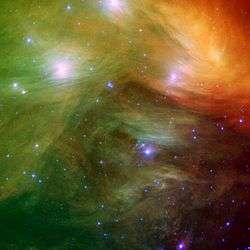Matariki


In the Māori language Matariki is both the name of the Pleiades star cluster and also of the season of its first rising[1] in late May or early June. This is a marker of the beginning of the new year. Different peoples celebrate Matariki at different times; some when Matariki rises in late May or early June while others observe it at the first full moon or first new moon following the rising of Matariki.[2] In 2017, Matariki begins on 4 July.
Similar words occur in most Polynesian languages, deriving from Proto-Polynesian *mataliki, meaning minute, small, and the use of the term for the Pleiades constellation is also ancient and has been reconstructed to Eastern Oceanic.[3][4]
Māori
The star cluster was important for navigation and timing the seasons. The first rising of the Pleiades and of Rigel (Puanga in northern Māori, Puaka in southern Māori) occurs just prior to sunrise in late May or early June. The actual time for the celebration of Matariki varies, some iwi (tribe or clan) celebrate it immediately, others wait until the rising of the next full moon, or the dawn of the next new moon—and others use the rising of Puanga/Rigel in a similar way.[5][6]
In traditional times, Matariki was a season to celebrate and to prepare the ground for the coming year. Offerings of the produce of the land were made to the gods, including Rongo, god of cultivated food. This time of the year was also a good time to instruct young people in the lore of the land and the forest. In addition, certain birds and fish were especially easy to harvest at this time.
The name Matariki is used also for the central star in the cluster, with the surrounding stars named Tupu-ā-nuku, Tupu-ā-rangi, Waitī, Waitā, Waipunā-ā-rangi and Ururangi.[7]

Recent revival

In 2001 The Māori Language Commission began a move to "reclaim Matariki, or Aotearoa Pacific New Year, as an important focus for Māori language regeneration". Since then it has increasingly become common practice for various institutions to celebrate Matariki[8][9] in a range of ways[10] and over the period of a week or month anywhere from early June to late August
National holiday proposals
With the wider recognition, there has been proposal to make Matariki an official holiday in New Zealand—in particular former Māori Party MP Rahui Katene's private member's bill Te Ra o Matariki Bill/Matariki Day Bill, drawn from the ballot in June 2009.
The Bill would have fixed the date of a public holiday using the new moon in June,[11] however this was later changed to the new moon of the heliacal rising of Matariki when the bill was drawn a month later and set down for introduction into Parliament.[12] Mayor of Waitakere City Bob Harvey supported the call to make Matariki a public holiday to replace Queen's Birthday,[13] along with the Republican Movement of Aotearoa New Zealand, which found none of New Zealand's local authorities held celebrations for Queen's Birthday, but many held celebrations for Matariki.[14] However, the Bill itself did not propose abolishing Queen's Birthday, and was voted down at its first reading.[15]
As part of the National–Māori Party agreement subsequent to the New Zealand general election, 2011, both parties agreed to support "[a] cultural heritage bill to recognise Matariki/Puanga, and to honour the peace-making heritage established at Parihaka."[16]
See also
- Matariki, a 2010 New Zealand drama film set in Otara, South Auckland
- Makahiki, an ancient Hawaiian New Year festival
References
- ↑ "... in New Zealand it was the heliacal rising of that group that marked the new year", The Astronomical Knowledge of the Maori, Elsdon Best
- ↑ "Matariki - the Māori New Year". Ministry for Culture and Heritage. 23 May 2017.
- ↑ Polynesian Lexicon Project Online, entries *mata-liki.1 and *mata-liki.2a
- ↑ "On Stars, and Star Lore", The Maori: Yesterday and To-day, James Cowan, 1930
- ↑ "Stars are set for a happy Maori New Year", Tariana Turia on the Maori Party website
- ↑ "Ranginui - the sky". Te Ara - The Encyclopedia of New Zealand.
- ↑ "Stars signal life cycle" (PDF). Te Ao Maori. June 2005. p. 23 (p 2 of the PDF). Retrieved 10 May 2011.
- ↑ "Sky Tower Lights Up to Celebrate Matariki" (Press release). Scoop (website)/SKYCITY. 10 June 2010. Retrieved January 15, 2013.
- ↑ "Matariki Festival @ Te Papa"
- ↑ "Libraries celebrate Matariki with higher interactivity", Christchurch City Council
- ↑ Tim Selwyn, Tumeke! blog 18 June 2009 Online
- ↑ "Matariki holiday bill to go before Parliament". Stuff.co.nz. NZPA. 22 July 2009. Retrieved 22 October 2011.
- ↑ "Mayor Joins Call For Matariki Public Holiday". Scoop.co.nz. 22 June 2009.
- ↑ "No Celebrations For Queen's Birthday". Scoop.co.nz. 29 May 2009.
- ↑ Katene, Rahui (20 August 2009). "Te Ra o Matariki Bill – Matariki Day Bill loses on first reading". tangatawhenua.com.
- ↑ "Relationship Accord and Confidence and Supply Agreement with the Māori Party" (PDF). Scoop.co.nz. 11 December 2011. Retrieved 15 February 2012.
External links
- Matariki at the Māori Language Commission
- Matariki Online Learning Resources from the Museum of New Zealand Te Papa Tongarewa
- Story: Matariki – Māori New Year at in Te Ara: the Encyclopedia of New Zealand
- Matariki – Māori New Year in Te Ara: the Encyclopedia of New Zealand
- Matariki: Awaiting their Ascent in Tangatawhenua.com
- Matariki Festival
- The First Lunar Month (June - July) at NZ Astronomy